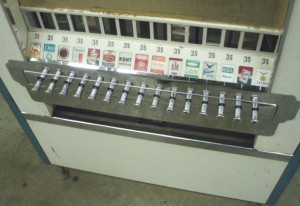Somehow, G.M. seems to be not only surviving but thriving after almost being left for dead a couple of years ago.
Lately they have been in the news quite a bit highlighting their plans to pay back the US government early for the bailout funds they received. They are talking about an IPO to generate the cash needed to complete the payback. Of course some of their recent success is the result of cash-for-clunkers and the continued struggles of Toyota and not because of anything smart they did. But I think I speak for a lot of people when I say “yawn.” Great for them, and really great for US jobs, but there wasn’t much to really get excited about regarding G.M.
Until today.
Saturday there were two articles in the paper about G.M., and both were done by Nick Bunckley. The first one that wasn’t a WOW, but showed signs of intelligent marketing life – Luxury Car As a Gift Stuns a Few, tells the story of how G.M. gave a Corvette to the pitcher Armando Gallarraga of Detroit who was denied becoming the 21st pitcher to throw a perfect game in major league history only because of a blown call at the end of the game. The article says the gift raised some eyebrows given that G.M. still owes a lot of money, but anyone who knows anything about brand and marketing knows that this was a very smart move. Yes. it’s a $50,000 car, but it didn’t cost GM that much to make it, and it was a low risk bet that the story would get picked up by ESPN and national news, and that sort of coverage is worth way, WAY more than $50,000, never mind the goodwill injection the brand got.
OK, so that was just a smart move, and an agile one.
The WOW article contributed by Mr. Bunckley was G.M. Forms $100 Million Technology Venture Firm, and that’s huge for G.M. because implicitly it acknowledges at least three big things:
1) They Are Stale.The reason G.M. almost died in the first place was because they became stale and boring and didn’t innovate at all. Of course people stop buying your product when that happens, unless of course you have a monopoly like a Comcast or a Microsoft.
2) People want technology in their car. If we have learned anything about cars lately, it’s that people want to do a lot of things other than driving in them. G.P.S. and cell phones were the beginning, but as those devices mature you can search for restaurants and other locations, get traffic warnings, customize the music you hear, show movies (in the back), etc. Just as Starbucks liked to be thought of as the #1 place people go to hang out beyond the home and work, those of us who spend hours and hours in the car, the car is on the verge of becoming a destination in its own right, ironically. Though somewhat subtle, this is a transformation of how we think about our time in the car and there is a LOT of money to be made in rethinking how we spend our time there.
 3) The Automotive Industry Is Getting Reinvented. Not tomorrow, but transportation is changing. The horrifying oil spill in the Gulf has renewed discussions of our need to get off of our dependence on oil, and while I think that’s both true and inevitable, I think the coming transformation is bigger than that. I have blogged in the past about how effectively Kodak successfully reinvented themselves by redefining the meaning of “The Kodak Moment”, Netflix has also successfully reinvented themselves in allowing people to stream movies directly instead of waiting for them in the mail (which is putting a lot of pressure on Comcast, by the way). In the case of both Kodak and Netflix, technology was what triggered the reinvention rethinking, and if they hadn’t reinvented themselves, I think both would have died or be near death soon. The reinvention that I think is coming is a more fundamental shift in the way we think about transportation. Already we are hearing about electric bikes and seeing things like the three-wheeled Can-Am (pictured at right) and I think those trends will only continue. The Zipcar is an idea that seemed a little kooky when it made its debut, but now it’s expected to go public it’s so popular. The trick for giants like G.M. is to understand what these trends mean to the market segments they target, and it might even mean targeting different markets.
3) The Automotive Industry Is Getting Reinvented. Not tomorrow, but transportation is changing. The horrifying oil spill in the Gulf has renewed discussions of our need to get off of our dependence on oil, and while I think that’s both true and inevitable, I think the coming transformation is bigger than that. I have blogged in the past about how effectively Kodak successfully reinvented themselves by redefining the meaning of “The Kodak Moment”, Netflix has also successfully reinvented themselves in allowing people to stream movies directly instead of waiting for them in the mail (which is putting a lot of pressure on Comcast, by the way). In the case of both Kodak and Netflix, technology was what triggered the reinvention rethinking, and if they hadn’t reinvented themselves, I think both would have died or be near death soon. The reinvention that I think is coming is a more fundamental shift in the way we think about transportation. Already we are hearing about electric bikes and seeing things like the three-wheeled Can-Am (pictured at right) and I think those trends will only continue. The Zipcar is an idea that seemed a little kooky when it made its debut, but now it’s expected to go public it’s so popular. The trick for giants like G.M. is to understand what these trends mean to the market segments they target, and it might even mean targeting different markets.
Either way, the big part of this idea is that they have set aside a bunch of money and built a team to look for great new ideas in technology. For a company like G.M., $100 million isn’t a huge amount, but it’s a great start, and my guess is that their new CFO, Chris Liddell who came from Microsoft had something to do with this. Liddell is rumored to be the next CEO at G.M. and it’s this sort of fresh and aggressive thinking that’s needed to get G.M. really rolling again, that will make their next CEO a success.
-Ric
 It’s vending machines, or as Stephanie Rosenbloom says the new term is “automated retail store” in her article
It’s vending machines, or as Stephanie Rosenbloom says the new term is “automated retail store” in her article 
 Businesses like Coinstar and Redbox, now owned by the same company were also a bit of a step forward in their own right. Coinstar, which allows you to dump all of your loose change into a bucket and quickly get cash back (for a fee of about 7% depending on how you do it), figured out that people are going to go to the grocery store anyway (unless, of course they use Amazon Fresh) and they have loose change that piles up, let’s offer them a service they want, that also saves the grocery store the trouble of stocking up on the change they have to hand out. Really great idea. Redbox, took the same premise and saved people a trip to the video store (or Netflix) and rents movies for only a dollar. The evolution there is that they have your credit card number so if you don’t return the movie, Redbox has a way to charge you.
Businesses like Coinstar and Redbox, now owned by the same company were also a bit of a step forward in their own right. Coinstar, which allows you to dump all of your loose change into a bucket and quickly get cash back (for a fee of about 7% depending on how you do it), figured out that people are going to go to the grocery store anyway (unless, of course they use Amazon Fresh) and they have loose change that piles up, let’s offer them a service they want, that also saves the grocery store the trouble of stocking up on the change they have to hand out. Really great idea. Redbox, took the same premise and saved people a trip to the video store (or Netflix) and rents movies for only a dollar. The evolution there is that they have your credit card number so if you don’t return the movie, Redbox has a way to charge you. Fast forward to 2010, and for the first time ever, Nordstrom has a store in Manhattan. Stephanie Rosenbloom recently published a nice piece about it
Fast forward to 2010, and for the first time ever, Nordstrom has a store in Manhattan. Stephanie Rosenbloom recently published a nice piece about it